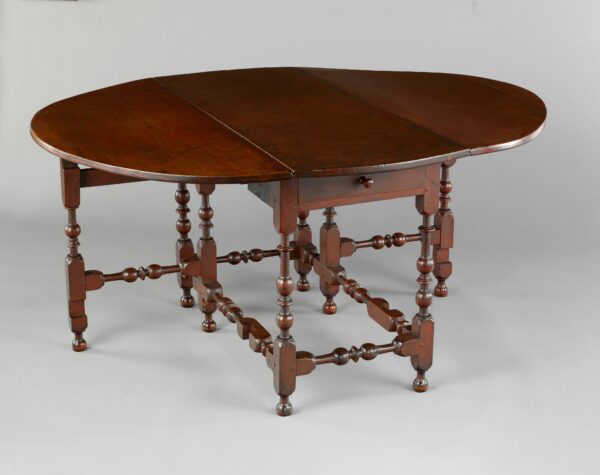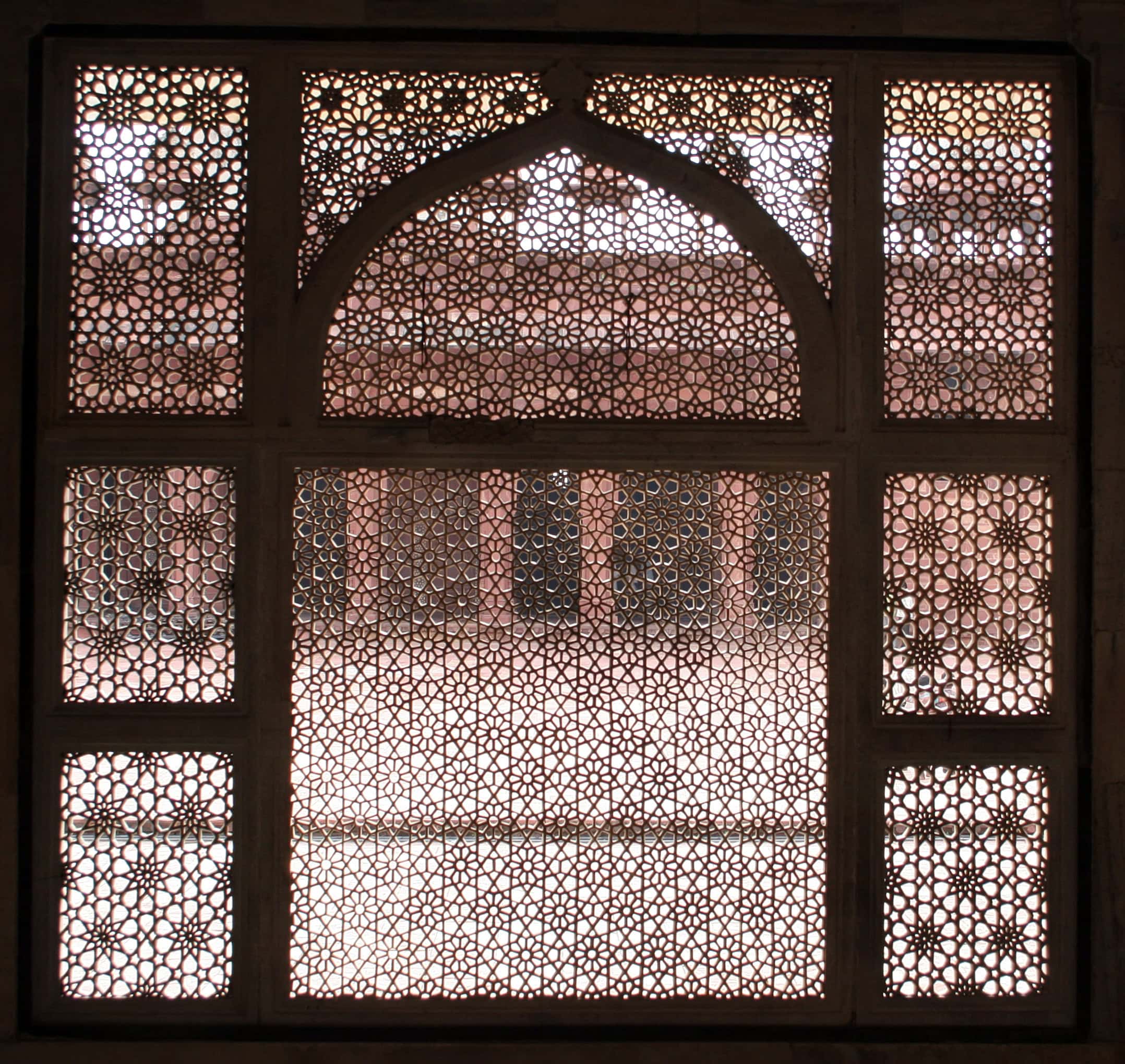I sit at a scarred but sturdy cherrywood table. Already antique in my childhood, it stood in the dining room of the farmhouse I grew up in. The computer I’m writing on is turning unreliable. The table? If anything, its reliability has increased with time, as I’ve come to understand.

Peggy Liss writes at an antique cherrywood gateleg table, a less elaborate version of this 18th-century maple table held at the Met. Metropolitan Museum of Art/Public domain
I am 94 years old, and a few years ago, I decided to write a memoir. It took on a life of its own when material things—furnishings, clothing, and food—intruded as organizing topics. As I located my individual experience within social context, I learned a lot of history, both personal and communal. I realized not only the trajectory of my life more fully but also ways that material culture is intrinsically a purveyor of the past, both history retaining and history making.
I was born in Philadelphia in 1927, an event announced by a pink-ribboned card preserved in a silk-bound baby book. My mother kept this book, and I have it today. In it, there’s a first photo of me in an intricately sewn white baby dress. Surviving, too, is the silver bowl from which I soon ate oatmeal or Cream of Wheat daily. My memoir is titled Bygone, and for good reason. These baby things of mine are artifacts that belong to the past, and while their presence jogs personal memories, in writing of my life, they also prompted me to search for historical context. That context I found persuasively set out in The Protestant Establishment: Aristocracy and Caste in America (1964) by E. Digby Baltzell, a sociologist who focused on his native Philadelphia. In the 1920s, he explained, social class was multilayered and taken for granted as blue collar, white collar (lower to middle), upper middle, and upper; those distinctions were displayed in where and how you lived; how you spoke, dressed, worked, and played; and the material things you lived with.
As I look back, I realized this bygone hierarchy of classes was conveyed to me early on by my parents. My mother was proud of being a third-generation American. My father, having arrived in 1882 as a child in a wave of eastern European immigrants escaping persecution, took pride in having done the American thing of pulling himself up by his bootstraps. Both were Jewish but otherwise from different worlds—my mother a claimant to German Jewish aristocracy, imbued with a view of class paralleling the wider, essentially Protestant, social structure, my father the scion of a rough-hewn family from then Russian Ukraine.
In their marriage, my parents found unity in embarking on a particular American way of life—in their case, an upper-middle-class lifestyle made visible in how they lived and the things they lived with. I was three when they left Philadelphia to settle into a renovated revolutionary era Bucks County farmhouse. Their move to the country, while indebted to the mobility that came with cars and trains, occurred within a trend initiated by Philadelphia’s upper-class exodus to suburbs and exurbs. My parents, consciously overriding their different pasts, went about melting into America as they knew it.
These baby things of mine are artifacts that belong to the past that prompted me to search for historical context.
In my childhood, the Stars and Stripes hung off the front porch every Fourth of July, and among the household furnishings were many newly acquired early American pieces, authenticating antiques. For in the 1930s and as long as clear class distinctions persisted, belonging to the upper crust had much to do with being born into it, the longer ago the better, and a visible sign was having inherited old things—nothing looking too new, things preferably handmade by a skilled craftsman long ago in the recognizable style of some past century. If you could not display actual old family pieces, second best were antiques reflecting “good taste.” I grew up, that is, amid trappings emblematic of high social class, “proper” clothes and foods and “good” old furnishings, all by hindsight grounding me within a family acculturated to America and within a class-proclaiming material culture.
By 1951, after some college and a stint as a newspaper reporter, and now married and with a child, as a matter of course, I turned to housewifery, a role much publicized in radio sitcoms, in popular magazines such as Woman’s Home Companion and Ladies’ Home Journal, and through the cookbook by (the mythical) Betty Crocker, all envisioning America as thoroughly middle class. While I did not read the magazines, I swore by Betty Crocker and steadily baked her never-fail layer cakes. Having lived through the social leavening that occurred during and after World War II, I thought of myself as grown up and moving outward into a wider and more open society than that of my parents. Still, and overall, my material tastes were no sharp break with the past. As inculcated in childhood, I continued to wear well-made things of good fabric and to eat healthily. My new-style ranch house, while complete with the latest appliances, also contained antique furnishings I had grown up with—inherited things that, while evoking a distant time and place in their style, had acquired further meaning interwoven with personal history, attesting to past and present as overlapping and continuous.
I’d been drawn to history early on, as existing in my material surroundings and family stories and in the children’s books I cherished. Stories of other times and places opened onto dimensions of a world far beyond my everyday life. Before and during the war had come events considered momentously historical in newspapers, on the radio, and talked about at home. When my children went to school, I diluted my housewifery by taking a history course at the local Penn State University branch. Then, juggling home and the renewed allure of other times and places, I continued at the University of Pennsylvania to a doctorate in 1965 and to teaching and writing of the—to me—omnipresent past.
The farmhouse antiques I grew up with intermingle with newer furnishings.
Today, my taste and my surroundings continue to retain vestiges of the ambiance of my childhood. In clothing, a style adopted by my mother and long considered classic echoes in the well-aged things I still wear. But, on occasion, those things mingle with jeans, T-shirts, and hoodies. And where only doubtful Americanized Chinese and Italian foods were once to be had, today I find widely available, and indulge in, an international feast. The farmhouse antiques I grew up with intermingle with newer furnishings. Together, these objects provide a connection through time enriching the ongoing present. History lives in them. They tell me personal stories enlivening both past and present, broadening memory and life.
Once upper-class identifiers and valued as such, antiques have slowly lost ground to changing taste and, as the old class divisions have withered, to new material signifiers of top-doggism. Today, antiques as such are not much sought after; fringely fashionable, they are at once victims and communicators of historical change. That said, in my living room are the two antique chairs that once faced each other across the farmhouse fireplace. I again see my parents sitting in them each evening. They are reading—my mother usually fiction, my father usually history. Although sometimes my father is playing Michigan rummy (whatever that was) with me. Or he gets up to teach me to waltz, his “One and two and three” accompanying the music of Johann Strauss on the record playing on the Victrola.
The cherrywood table at which I now write once stood in the farmhouse dining room, and its daily presence embodies both American history and my own. Further, while it bridges time, its shape and form have not changed over the years. Only its use and users have, and there it offers an analogy to history itself. The actuality of the past is unchanging, yet its study has proven far more malleable, subject to being shaped and reshaped (as historiography attests) and often in accord with current concerns that open new approaches to a bygone world but can also obscure the shape and form of a different time and place, antique in its own right.
The table attests to something more. In The Meaning of Things: Domestic Symbols and the Self (1981), psychologist Mihaly Csikszentmihalyi and sociologist Eugene Rochberg-Halton distinguish between “terminal materialism” as just that, a dead end, and “instrumental materialism” as a catalyst to unleashing creative energies. They see valued domestic objects as important to human existence and especially to its quality. “The possessions one selects to endow with special meaning out of the total environment of artifacts,” they conclude, “are both models of the self as well as templates for further development. They serve to give a tangible expression and thus a continued existence through signs to one’s relationships, experiences, and values.” This is precisely my own sentiment—something that has slowly dawned on me while writing my memoir.
Plumbing my own history has affirmed something further, however: that artifacts deposited by the past also attest to the tendency of the old to linger within the new. In the seemingly inevitable elision of past into present, present into future, I’ve found material culture can be the canary in the coal mine, alerting a historian to broader changes in the air, as it has throughout my lifetime.
Peggy Liss is the author of, among other books, Isabel the Queen: Life and Times and has recently completed “An Almost Chosen People: Faith, History, and the Political Power of Words,” tracing religiously infused American political language back to earliest times. She served on the AHA Council and Executive Committee from 1985 to 1988.
This work is licensed under a Creative Commons Attribution-NonCommercial-NoDerivatives 4.0 International License. Attribution must provide author name, article title, Perspectives on History, date of publication, and a link to this page. This license applies only to the article, not to text or images used here by permission.


